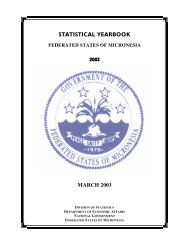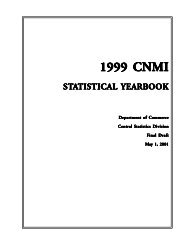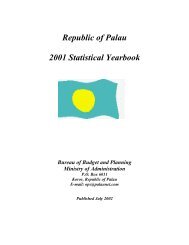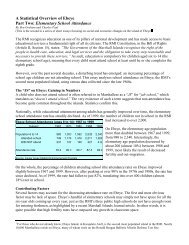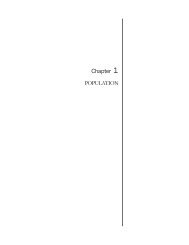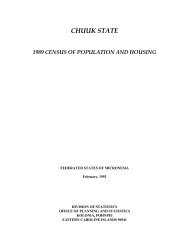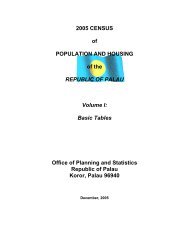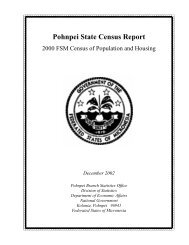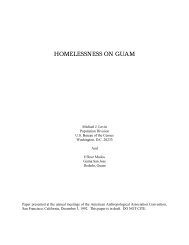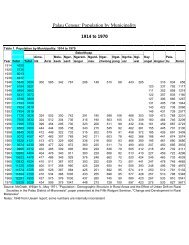Chuuk State Census Report - pacificweb.org
Chuuk State Census Report - pacificweb.org
Chuuk State Census Report - pacificweb.org
You also want an ePaper? Increase the reach of your titles
YUMPU automatically turns print PDFs into web optimized ePapers that Google loves.
Chapter 1. Introduction2000 FSM <strong>Census</strong> of <strong>Chuuk</strong> <strong>State</strong>Table 1.7. Population of <strong>Chuuk</strong> by Region of Registration and Region of Residence (horizontal): 1930Region of RegistrationRegion of Residence Number Total Same locality Same district Other district Other locationTotal 15,200 100.0 89.0 10.4 0.5 0.1Northern Namoneas 2,613 100.0 91.1 8.2 0.8 -Southern Namoneas 3,911 100.0 78.1 20.8 0.6 0.4Faichuk 3,638 100.0 92.6 7.4 0.1 -Mortlocks 3,400 100.0 95.4 4.3 0.3 -Oksoritod 1,638 100.0 90.4 8.1 1.5 0.1Source: Nan'yo-cho 1931; 2000 FSM <strong>Census</strong>.The distribution of registration for Faichuk and Northern Namoneas was similar to that seen for Oksoritod, but thesituation for Southern Namoneas was quite different. This difference is probably partly attributable to the Japanesebuild up centered around Fefen, capital of <strong>Chuuk</strong> during the period. About 1 in every 5 persons living in SouthernNamoneas in 1930 was from some place else in <strong>Chuuk</strong>. This proportion was about twice the proportion for all of<strong>Chuuk</strong>.When we run the percentages vertically instead of horizontally, a different picture emerges (Table 1.8). In 1930, about1 in 4 persons lived in Southern Namoneas, another 1 in 4 in Faichuk, another 1 in 4 in the Mortlocks, and the rest livesin Northern Namoneas and Oksoritod. The percentage distribution of the 89 percent of the population living in thesame locality was almost identical to the distribution for the whole population -- not too surprising since these peoplemade up the vast majority of persons living in <strong>Chuuk</strong> at that time. However, if we do look at the 1,575 persons whowere not living in the same locality, but were living in <strong>Chuuk</strong>, we see a different pattern -- that is, more than half ofthose persons were living in Southern Namoneas, again, probably either forcibly moved by Japanese, or moving oftheir own accord to work or, perhaps, go to school, in the capital of that time. Of the 80 persons registered in otherdistricts, 24 (30 percent) were living in Oksoritod, and 17 of the 19 persons registered in "another" location were livingin Southern Namoneas.Table 1.8. Population of <strong>Chuuk</strong> by Region of Registration and Region of Residence (vertical): 1930Region of Registration (Percent)Same Same Other OtherRegion of residence Number Total Locality District District LocationTotal 15,200 ... 13,529 1,575 80 19Percent ... 100.0 100.0 100.0 100.0 100.0Northern Namoneas 2,613 17.2 17.6 13.6 26.2 -Southern Namoneas 3,911 25.7 22.6 51.7 28.3 89.1Faichuk 3,638 23.9 24.9 17.0 4.0 -Mortlocks 3,400 22.4 24.0 9.3 11.5 5.5Oksoritod 1,638 10.8 10.9 8.4 30.0 5.5Source: Nan'yo-cho 1931; 2000 FSM <strong>Census</strong>.By 1935, the percentage of elderly had increased slightly, but the percentage distributions remained relativelysimilar to those in 1930 (Table 1.9). The percentage of persons 15 to 24 of all those in Southern Namoneas,however, jumped considerably -- indicating that young people were moving there for schooling, and, perhaps, forwork. The percentage of persons less than 15 remained higher in the Mortlocks than elsewhere, lower in Oksoritodthan elsewhere.Table 1.9. Population of <strong>Chuuk</strong> by Age Group and Region: 1935Region Number Total 0-14 years 15-24 years 25-59 years 60 years or moreTotal 15,129 100.0 37.8 18.4 41.0 2.8Northern Namoneas 2,413 100.0 36.6 16.9 42.4 4.0Southern Namoneas 4,379 100.0 35.8 22.1 39.7 2.4Faichuk 3,388 100.0 38.4 16.3 42.6 2.7Mortlocks 3,401 100.0 42.2 17.6 37.6 2.6Oksoritod 1,548 100.0 34.1 16.3 46.9 2.7Source: Nan'yo-cho 1937; 2000 FSM <strong>Census</strong>.As noted before, the number of <strong>Chuuk</strong>ese in <strong>Chuuk</strong> did not change during the Japanese period, somewhat of anindictment of the Japanese Administration since, by this time, sufficient knowledge of health practices was available togreatly reduce what must have been very high mortality rates. During the war the natives of <strong>Chuuk</strong> were greatlyoutnumbered by Japanese military personnel. By August 1946, however, all Japanese except some 1,300 officers and10 <strong>Chuuk</strong> Branch Statistics Office, Division of Statistics, FSM Department of Economic Affairs



